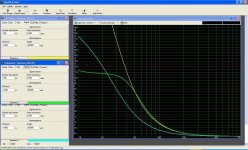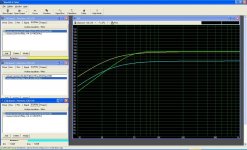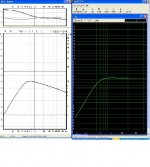Hi,
I am trying to find a suitable box size and LT-transform for a sealed XXLS 10" based woofer to be used fairly high up in frequency, to about 120-160 Hz, for music use mostly. I use winisdpro for modelling and I'm now trying to figure out how to design this so that I don't risk exceeding the driver's xmax. Can someone help me by explaining how I should think regarding excursion and amplifier power, what is the best solution here...? I have searched this forum and read Linkwitz, but I'm afraid I don't get it all yet ...
If I have a closed box of 40 liters I can enter a signal of 105 watts and the excursion stays below xmax all the way. If I also add an LT-transform (Fp=25Hz, Qp=0.55) then the excursion exceeds xmax already at about 38 Hz. Reducing the signal to about 25 watts makes the excursion stay below xmax until 20 Hz.
The reason is use the figure 105 watts is that I was hoping to use a certain amplifier giving 105 watts into 8 ohms, but I am in no way limited to that specific amp.
BTW: If I model a small box of 14 liters then I won't exceed xmax even when having a signal of 105 watts + LT, but that causes a small and somewhat ugly hump in the respons at about 100 Hz ... is this the way to go?
Regards,
M.A.
I am trying to find a suitable box size and LT-transform for a sealed XXLS 10" based woofer to be used fairly high up in frequency, to about 120-160 Hz, for music use mostly. I use winisdpro for modelling and I'm now trying to figure out how to design this so that I don't risk exceeding the driver's xmax. Can someone help me by explaining how I should think regarding excursion and amplifier power, what is the best solution here...? I have searched this forum and read Linkwitz, but I'm afraid I don't get it all yet ...
If I have a closed box of 40 liters I can enter a signal of 105 watts and the excursion stays below xmax all the way. If I also add an LT-transform (Fp=25Hz, Qp=0.55) then the excursion exceeds xmax already at about 38 Hz. Reducing the signal to about 25 watts makes the excursion stay below xmax until 20 Hz.
The reason is use the figure 105 watts is that I was hoping to use a certain amplifier giving 105 watts into 8 ohms, but I am in no way limited to that specific amp.
BTW: If I model a small box of 14 liters then I won't exceed xmax even when having a signal of 105 watts + LT, but that causes a small and somewhat ugly hump in the respons at about 100 Hz ... is this the way to go?
Regards,
M.A.
look for "amplifier apparent load power"
dunno exactly how that Linkwitz transformation operates, but it is certain that with any boost you also need more power from aplifier. so adjust the "Linkwitz" and cabinet size so that the needed power from aplifier doesn't rise over 105w + enought SPL is achieved.
managing excursion might not actually be quite so crucial, the driver has +-25mm xmech. Reaching its mechanical limits in closed enclosure (with that spesific amplifier) is very unlikely to happen.
(yehaa! my noobie treatment just ended..)
dunno exactly how that Linkwitz transformation operates, but it is certain that with any boost you also need more power from aplifier. so adjust the "Linkwitz" and cabinet size so that the needed power from aplifier doesn't rise over 105w + enought SPL is achieved.
managing excursion might not actually be quite so crucial, the driver has +-25mm xmech. Reaching its mechanical limits in closed enclosure (with that spesific amplifier) is very unlikely to happen.
(yehaa! my noobie treatment just ended..)
I could not resist simulating this system in Basta!. It can be seen that below ~80 Hz, the maximum output level is limited by Xmax. Changing the Linkwitz transform will not change that at all. Using a larger box will shift the knee between Xmax and power limitation towards higher frequencies.
Curves are: Gray: max output level (MOL). Red: Cone excursion at MOL. Purple: Voltage required to reach MOL. Black: Frequency response. Green: Impedance. Blue: Amplifier voltage.
You must make the box quite heavy, though, since it will start to "walk" otherwise. Here is a movie of a 14 liter XLS10 with a PR walking... To make this particular box stand still on the floor, we had to put more than 10 kg of weight on top of it. You should also be aware that the pressure inside the box will be extremely high (164 dB below 80 Hz at MOL), an that this introduces extra distortion.
You should also be aware that the pressure inside the box will be extremely high (164 dB below 80 Hz at MOL), an that this introduces extra distortion.
http://www.tolvan.com/lillkub.avi
Driver: 830842, closed box 14 liter.
An externally hosted image should be here but it was not working when we last tested it.
Curves are: Gray: max output level (MOL). Red: Cone excursion at MOL. Purple: Voltage required to reach MOL. Black: Frequency response. Green: Impedance. Blue: Amplifier voltage.
You must make the box quite heavy, though, since it will start to "walk" otherwise. Here is a movie of a 14 liter XLS10 with a PR walking... To make this particular box stand still on the floor, we had to put more than 10 kg of weight on top of it.
http://www.tolvan.com/lillkub.avi
Driver: 830842, closed box 14 liter.
Basta vs. winisdpro
Thanks for your replys,
I gave Basta a try and it gave me about the same result as your plot Svante (as it should ...), apart from the excursion plot which I couldn't do, probably because I have the free demo version only.
Why does the shape of the Basta predicted response look different compared to winisdpro, I'm talking about the fall off above 90-100 Hz which is pretty flat using winisdpro?
Can you guys give me a clue as to what SPL target I should look for if I want a system playing at fairly moderat levels appropriate for an appartment building? Winsidpro says that I can get about 100 dB from a single XXLS 10" woofer giving it 25 watts ...
My plan is to go for two woofer boxes, which should give me 6 dB extra compared to only one. Room gain should also add a significant bass boost, some times as much as 18 dB according to Linkwitz.
Regards,
M.A.
Thanks for your replys,
I gave Basta a try and it gave me about the same result as your plot Svante (as it should ...), apart from the excursion plot which I couldn't do, probably because I have the free demo version only.
Why does the shape of the Basta predicted response look different compared to winisdpro, I'm talking about the fall off above 90-100 Hz which is pretty flat using winisdpro?
Can you guys give me a clue as to what SPL target I should look for if I want a system playing at fairly moderat levels appropriate for an appartment building? Winsidpro says that I can get about 100 dB from a single XXLS 10" woofer giving it 25 watts ...
My plan is to go for two woofer boxes, which should give me 6 dB extra compared to only one. Room gain should also add a significant bass boost, some times as much as 18 dB according to Linkwitz.
Regards,
M.A.
propably because of driver inductance "Le". value might not be given for this driver.. there are also some bugs in winisd.. in one version it showed the effect of Le only in closed cabinet.. which is response going down as frequency goes up, this happens lower with bigger inductance.. think it as drivers own coil crossing itself over 1th order at some frequency determined by the inductance (in cooperation with driver resistance, like when calculating value of 1th order lowpass for bass you need to know what ohm the driver is).
i myself prefer not putting that parameter in driver data as the result for some reason doesn't seem to go hand to hand with the reality, propably the effect is real- woofer takes less and less power going up in frequency (can be seen in rising impendance), but effect on magnitude doesn't equal that. those simulation programs don't know it and show response very different from actual measurements you can have from manufacturer. better look the frequency graph from www.tymphany.com for higher frequencies, or not use the Le value.
just my take..
anyways when you have plain closed cabinet of some particular size and put "system input power" the wattage of your amplifier -then look for spl and you now see max spl for any frequency for that amplifier speaker -combination. indifferent with LW transformation, as it doesn't give you more spl, just tunes the frequency. then lookin at the cone excursion you see how much of xmax you get to use ~100 wats is quite little for that driver. well, least you don't get much compression from suspension there.
it is hard (impossible) to tell what would be correct boost for your room and liking, can't you make it adjustable somehow?
i myself prefer not putting that parameter in driver data as the result for some reason doesn't seem to go hand to hand with the reality, propably the effect is real- woofer takes less and less power going up in frequency (can be seen in rising impendance), but effect on magnitude doesn't equal that. those simulation programs don't know it and show response very different from actual measurements you can have from manufacturer. better look the frequency graph from www.tymphany.com for higher frequencies, or not use the Le value.
just my take..
anyways when you have plain closed cabinet of some particular size and put "system input power" the wattage of your amplifier -then look for spl and you now see max spl for any frequency for that amplifier speaker -combination. indifferent with LW transformation, as it doesn't give you more spl, just tunes the frequency. then lookin at the cone excursion you see how much of xmax you get to use ~100 wats is quite little for that driver. well, least you don't get much compression from suspension there.
it is hard (impossible) to tell what would be correct boost for your room and liking, can't you make it adjustable somehow?
Re: Basta vs. winisdpro
Probably you have entered Le=0 in WinISD?
Le acts as a lowpass filter and the XXLS drivers has a pretty large Le which makes this drop occur at a rather low frequency. The drop is however overestimated for this particular driver. It has rather an ugly cone break-up at ~650 Hz, and the slope of that break-up actually flattens the overall response below 500 Hz. Since Basta! (and most other simulators) does not model cone break-up there is a mismatch here.
Try making the Basta! response window transparent (Tools|View options) and put it on top of the response graph from Peerless and you will see the differences:
mac-attack said:Thanks for your replys,
Why does the shape of the Basta predicted response look different compared to winisdpro, I'm talking about the fall off above 90-100 Hz which is pretty flat using winisdpro?
Probably you have entered Le=0 in WinISD?
Le acts as a lowpass filter and the XXLS drivers has a pretty large Le which makes this drop occur at a rather low frequency. The drop is however overestimated for this particular driver. It has rather an ugly cone break-up at ~650 Hz, and the slope of that break-up actually flattens the overall response below 500 Hz. Since Basta! (and most other simulators) does not model cone break-up there is a mismatch here.
Try making the Basta! response window transparent (Tools|View options) and put it on top of the response graph from Peerless and you will see the differences:
An externally hosted image should be here but it was not working when we last tested it.
Yepp, its the inductance that is behind the high end roll-off. What I did was entering Le in Basta and not in winisdpro, however both simtools behave the same when entering/not entering Le.
The high-end behavior might be important since I'm looking at crossing this thing kind of high. I more and more realize that I probably have to build something and measure it, rather than simulating to much. Though, I hope that sims can at least give me a good starting point for my build.
Obeman: my filters won't be adjustable when they are finished, but there sure will be some tweaking on the way ...
Thanks,
M.A.
The high-end behavior might be important since I'm looking at crossing this thing kind of high. I more and more realize that I probably have to build something and measure it, rather than simulating to much. Though, I hope that sims can at least give me a good starting point for my build.
Obeman: my filters won't be adjustable when they are finished, but there sure will be some tweaking on the way ...
Thanks,
M.A.
mac-attack said:The high-end behavior might be important since I'm looking at crossing this thing kind of high. I more and more realize that I probably have to build something and measure it, rather than simulating to much. Though, I hope that sims can at least give me a good starting point for my build.
Actually, a sub can be simulated very well. Measurements are much more important for higher frequencies. The use for measurements on a sub is mainly to find out how well the sub works together with the room.
- Status
- This old topic is closed. If you want to reopen this topic, contact a moderator using the "Report Post" button.
- Home
- Loudspeakers
- Subwoofers
- XXLS 10" excursion & power modelleing using winisdpro


